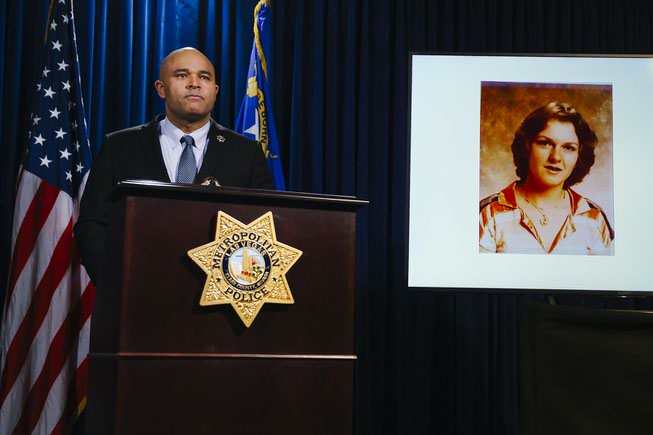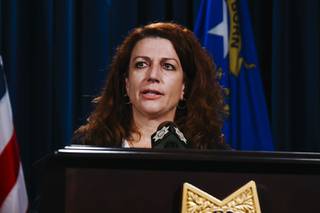
Metro Police Lt. Raymond Spencer speaks during a news conference at department headquarters Monday, Nov. 29, 2021. He identified the perpetrator in the 1979 slaying of 16-year-old Kim Bryant.
Monday, Nov. 29, 2021 | 5:30 p.m.
Advanced DNA technology has allowed Las Vegas police to finally say who they believe killed young Kim Bryant more than 40 years ago.
DNA left on Kim’s body tied Johnny Blake Peterson to the kidnapping, sexual assault and murder of the girl, a 16-year-old Western High School student who went missing in January 1979, Metro Police Lt. Raymond Spencer said Monday.
Peterson died in 1993, but Spencer said Peterson’s identification could bring closure.
“Nothing frustrates me more than when we’re not able to solve a case,” Spencer said. “Nothing’s going to make the pain go away, but at least the family has some closure. I want the community to know that — that we never stop working these cases and never stop following up on every lead.”
Othram Inc., a private laboratory in Texas, built a genealogical profile of Peterson from preserved DNA taken from Kim’s body at her autopsy in 1979 and uploaded it to multiple law enforcement and commercial genealogical DNA databases to see what connections it could make to distant relatives. Further testing by Metro’s forensic laboratory confirmed the findings.
“We work that family tree until we get to a point that we then go back to the investigators and say, ‘Here’s some information on some people that if you’ve got their date of birth, where their family’s from, where their parents were born, and get that back to us, we can start filling holes in the puzzle,’” said Michael Vogen, Othram’s director of case management.
Metro’s investigators found a local relative willing to take a genetic test that brought the case together.
“Kim was a beautiful girl with a bright future, and it makes me happy that something is being done to help solve cases such as hers,” Kim’s father, Edward Elliott, said in a statement through Spencer.
Kim Murga, Metro’s forensic laboratory director, said investigators looked for a DNA hit in the Bryant case in 2008 but couldn't put together a profile. Technology continued to advance and investigators tried again in January. That time, they found male DNA on some evidence and entered it into a national database, but it didn’t get a hit.
After Othram, with funding from local tech entrepreneur and philanthropist Justin Woo, used scant DNA evidence to name a suspect earlier this year in the unrelated 1989 abduction, beating, rape and strangulation of 14-year-old Eldorado High student Stephanie Isaacson, the lab, Woo and Metro again teamed up to solve more cold cases.
Metro chose the Bryant case, which shared many similarities to the Isaacson case.
Kim’s mother reported her missing on Jan. 26, 1979, after she didn’t return home from school that day. She was last seen that morning at a Dairy Queen restaurant near North Decatur Boulevard and U.S. 95, across the street from her school.
Her body was found about a month later in the desert near West Charleston Boulevard and South Buffalo Drive. Detectives believe Peterson abducted Bryant the day she went missing, then raped and killed her. She had been beaten to death.
Peterson would have been 19 years old at the time of Kim’s murder. He was living in Las Vegas at the time and had previously attended Western High, though he wasn’t a schoolmate at the time of the murder and it wasn’t clear if he knew Kim.
Police are still looking into his connections to Kim or any other crimes. He was arrested in 1980 for another rape in Las Vegas, but that case was dismissed, Spencer said.
Woo — founder of the nonprofit Vegas Helps, which aims to fund “acts of kindness” — said community leaders are launching an initiative called the Vegas Justice League to solve additional cold cases.

